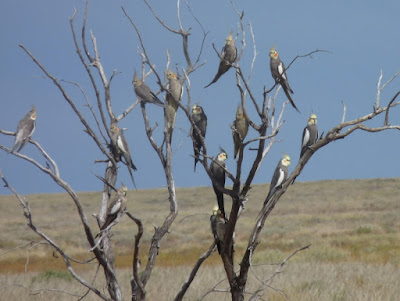Continuing from last week, which seems to have generated some interest I'm happy to say. I won't reiterate last week's introduction, but will move on to introduce some very dimorphic couples indeed, birds which in at least some cases you'd have to know belonged to the same species. These are not just a question of more and less intense versions of the same colour patterns, but quite different ones. However, having said that, I readily acknowledge that such observations are of necessity subjective, and where one type of dimorphism blends into the other is a very fuzzy line indeed.
Where they are truly distinctive however, and the name is descriptive, as so many names are, it means the bird is named only for the male - keep your eye open for this blatant discrimination as you browse!
Mostly in dimorphic species the male is brightly coloured while his mate is not, but this isn't always the case even in species where the male is the dominant partner in terms of courtship and display (we saw a couple of examples last week where the female was dominant, brighter or bigger). I recently had the pleasure of the company of a pair of birds which demonstrated this impressively, at a beautiful campsite at Gunlom Falls in Kakadu National Park in the Northern Territory.
Another Australian example is that of the widespread, but in most places not especially common, big duck, the Australian Shelduck Tadorna tadornoides; it is not readily possible to state which of the sexes is more brightly coloured - they're just very different!
 |
| Australian Shelduck pair, Bethungra Reservoir, New South Wales, male right, female left. A very poor old pic, my apologies; a slightly better photo of the male below, at Esperance, Western Australia. |
A related group of birds, the South American 'geese', also have very different male and female plumage, but both are also equally striking.
 |
| Above Kelp Geese Chloephaga hybrida, Chiloé Island, Chile and below Upland Geese C. picta, far southern Chile. In both cases the males are white and the females are coloured. |
Other such South American examples can be found among the marvellous hummingbirds.
 |
| Green Thorntail pair Discosura conversii, Mindo Valley, north-west of Quito, Eucador; male on the left. |
In most of the cases which follow however it's pretty straight-forward - the males have relatively striking colouration and the females are essentially brown, which is an excellent colour to be if you don't want to be noticed while sitting vulnerably on a nest.
Many of the Australian 'robins' (which are no more robins than our wrens are wrens!) follow a similar approach.
 |
| Flame Robin Petroica phoenicea pair, taking a break from attacking the invaders in the mirror, Namadgi NP near Canberra. |
 |
| Hooded Robins Melanodryas cucullata, central Australia, above and below. I seem to be incapable of taking a decent picture of this species, but I'll keep trying! |
The whistlers form another familiar Australian group which shows strong dimorphism.
 |
| Rufous Whistler male (Tinbinbilla Nature Reserve near Canberra) and female (Mt Scoria Conservation Park, Queensland) |
Other monarch flycatchers in addition to the Shining Flycatcher featured above show dimorphism, even though the females aren't as strikingly coloured.
 |
| Leaden Flycatcher Myiagra rubecula male (Mareeba Wetlands, Queensland) and female, Namadgi National Park near Canberra, below. |
Trillers are a group of small cuckoo-shrikes (family Campephagidae) which show strong dimorphism, unlike the larger members of the family.
Another group which varies considerably between species with regard to the differences between males and females are the parrots, most of which show no such traits. Some do however.
 |
| Red-rumped Parrot Psephotus haematonotus pair, Canberra. An exquisite little ground-feeding parrot, common in suburban parks. |
 |
| Red-winged Parrot pair Aprosmictus erythropterus; a glorious parrot found across much of the tropics and eastern inland Australia, as well as southern New Guinea. |
As noted above and last week, ducks are well-represented in lists of dimorphic birds. Here are a couple more strong contenders.
 |
| Above Chestnut Teals Anas castanea, south coast New South Wales, and below, Cinnamon Teals Anas cyanoptera, Arica, northern Chile. |
 |
And now that we've returned to South America, let's stay there to finish off today's exploration, beginning with one of the continent's truly iconic birds.
 |
| Andean Cocks-of-the-Rock Rupicola peruvianus, males above at a display lek, female, below, eastern slopes of the southern Peruvian Andes. |
 |
| Austral Negritoes Lessonia rufa, southern Chile, above and below. These active little ground-feeders are members of the old South American family of tyrant-flycatchers. |
Finally, trogons are one of the more spectacular bird families, comprising some 40 species across the world's tropical and sub-tropical zones - except for Australia. Many are notably dimorphic.
 |
| Masked Trogons Trogon personatus, Andean cloud forests north-west of Quito, Peru. |
Well, if nothing else I hope you've enjoyed meeting some pretty impressive birds, with a special characteristic.
Next time I'll look at a place, probably featuring somewhere from my recent travels in Australia.
BACK
ON THURSDAY
(And remember that you can get a reminder when the next post appears by putting your
email address in the Follow by Email box in the top right of this screen.)
(And remember that you can get a reminder when the next post appears by putting your
email address in the Follow by Email box in the top right of this screen.)

















































